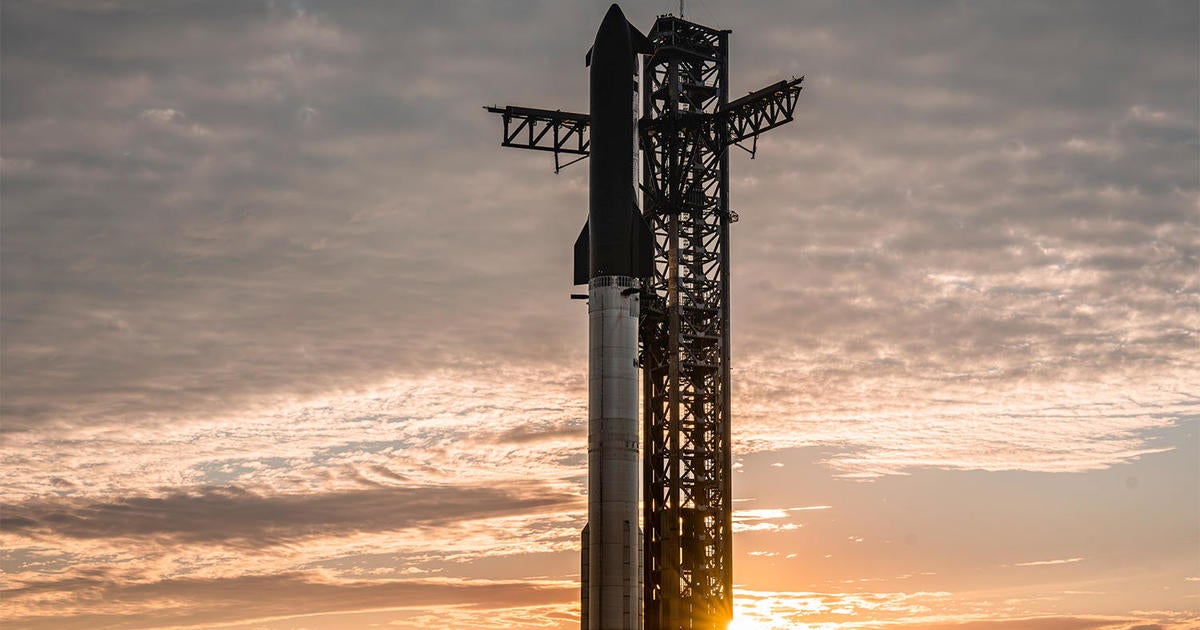After launching more than 100 small payloads from California Tuesday and two commercial moon landers from Florida early Wednesday, both atop Falcon 9 rockets, SpaceX readied a huge Super Heavy-Starship for a ground-shaking launch from the Texas Gulf Coast to kick off the program’s seventh test flight.
Liftoff from SpaceX’s Boca Chica manufacturing and flight test facility was planned for 5 p.m. EST, weather permitting.
SpaceX
The Super Heavy-Starship is the most powerful rocket ever built, generating a staggering 16 million pounds of thrust at liftoff using 33 methane-fueled Raptor engines burning 40,000 pounds of propellant per second.
As with previous test flights, the Super Heavy first stage was expected to boost the Starship upper stage out of the dense lower atmosphere before falling away and heading back to the launch site for recovery. The Starship relies on six Raptor engines of its own to reach space.
For these initial test flights, the Starships do not attempt to reach orbit. Instead, they loop halfway around the planet and descend belly-first through a hellish blaze of atmospheric friction before flipping nose up for a tail-first, rocket-powered splashdown in the Indian Ocean.
For the third flight in a row, SpaceX planned an attempt to “catch” the Super Heavy first stage after it propelled the Starship out of the lower atmosphere, snagging it on the way down using giant mechanical arms known as chopsticks mounted on the launch tower.
The first such catch last October was successful, a spectacular sight to thousands of cheering residents and tourists. But the Super Heavy used for the next such flight a month later was diverted to a Gulf of Mexico splashdown because of launch damage to sensors on the tower that were needed to help guide the descending booster into position.
SpaceX
New sensors now have more robust shielding to eliminate such damage and SpaceX engineers are optimistic they’ll soon be recovering Super Heavy boosters with the same regularity they’ve demonstrated with the company’s workhorse Falcon 9 rockets.
In keeping with the reusability theme, the Super Heavy’s 33 Raptor engines included one that flew on a previous test flight to demonstrate its ability to fly multiple missions.
But the bulk of the upgrades being tested Wednesday were built into what SpaceX called a “new generation” Starship.
What’s new in the “new generation” Starship
The upper stage’s forward stabilizing fins are smaller and have been repositioned to reduce their exposure to re-entry heating. An improved propulsion avionics system was added, along with redesigned fuel feed lines and a 25 percent increase in propellant volume to improve performance.
The redesigned avionics system includes a more powerful flight computer, new antennas that combine signals from Starlink and GPS navigation satellites, “smart batteries” and power units to drive two dozen high-voltage actuators and redesigned navigation sensors.
SpaceX also added additional cameras, with more than 30 on board to provide direct views of critical systems, using Starlink satellites to stream real-time video and data to the ground.
SpaceX
In another first, 10 mockup Starlinks were on board the Starship to test the rocket’s payload deployment system. The mockups were to be ejected one at a time, in Pez candy dispenser fashion, once the Starship reached space.
While the Starship is designed to be fully reusable, SpaceX has not yet made any attempts to capture a returning Starship or, for that matter, a Falcon 9 upper stage.
But Wednesday’s test flight featured multiple experiments to test a variety of heat shield improvements, including metallic tiles and one with active cooling, along with dummy Starship catch fittings, to learn more about how they will respond to re-entry heating.
“This new year will be transformational for Starship,” SpaceX said on its website, “with the goal of bringing reuse of the entire system online and flying increasingly ambitious missions as we iterate towards being able to send humans and cargo to Earth orbit, the moon, and Mars.”
Getting the Super Heavy-Starship flying on a regular basis is critical to NASA’s Artemis moon program. NASA is paying SpaceX to develop a variant of the Starship upper stage to carry astronauts down to the lunar surface in the 2027 timeframe.
To send a Starship to the moon, SpaceX must first launch it to low-Earth orbit where a succession of other Starship “tankers” will have to rendezvous, dock and autonomously refuel the moon-bound ship so it can blast out of Earth orbit and head for deep space.
Astronauts launched in an Orion capsule atop NASA’s Space Launch System rocket then will rendezvous with the Starship in orbit around the moon for the descent to the surface.
NASA’s contract requires one unpiloted lunar landing test flight before astronauts can be cleared to ride one down to the surface. The ongoing test program will determine when that might be possible.



